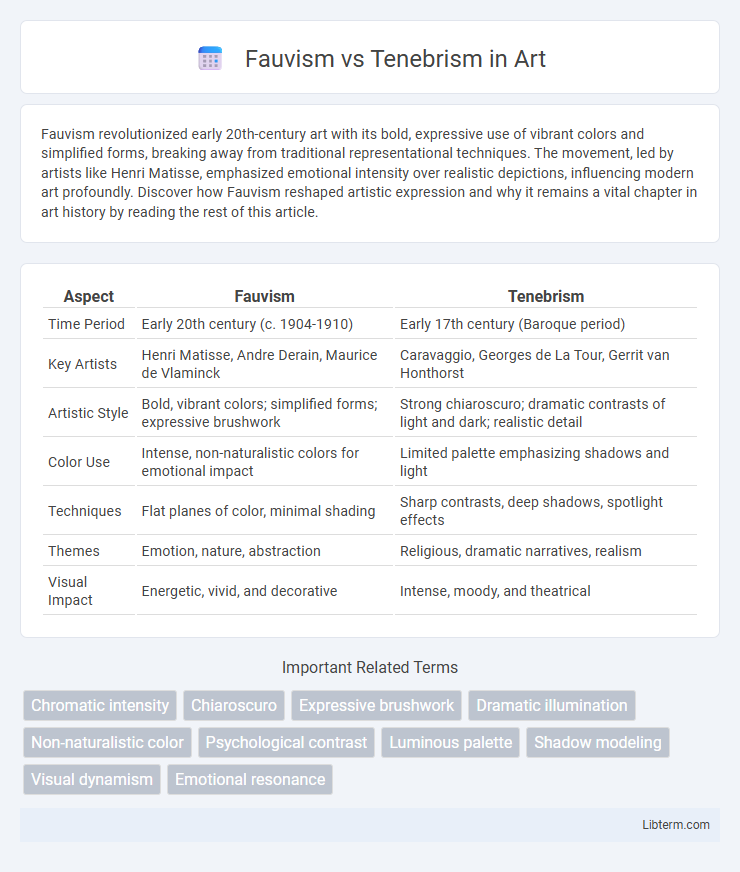Fauvism revolutionized early 20th-century art with its bold, expressive use of vibrant colors and simplified forms, breaking away from traditional representational techniques. The movement, led by artists like Henri Matisse, emphasized emotional intensity over realistic depictions, influencing modern art profoundly. Discover how Fauvism reshaped artistic expression and why it remains a vital chapter in art history by reading the rest of this article.
Table of Comparison
| Aspect | Fauvism | Tenebrism |
|---|---|---|
| Time Period | Early 20th century (c. 1904-1910) | Early 17th century (Baroque period) |
| Key Artists | Henri Matisse, Andre Derain, Maurice de Vlaminck | Caravaggio, Georges de La Tour, Gerrit van Honthorst |
| Artistic Style | Bold, vibrant colors; simplified forms; expressive brushwork | Strong chiaroscuro; dramatic contrasts of light and dark; realistic detail |
| Color Use | Intense, non-naturalistic colors for emotional impact | Limited palette emphasizing shadows and light |
| Techniques | Flat planes of color, minimal shading | Sharp contrasts, deep shadows, spotlight effects |
| Themes | Emotion, nature, abstraction | Religious, dramatic narratives, realism |
| Visual Impact | Energetic, vivid, and decorative | Intense, moody, and theatrical |
Introduction to Fauvism and Tenebrism
Fauvism, emerging in the early 20th century, is characterized by bold, vibrant colors and simplified forms, emphasizing emotional expression over realistic representation. Tenebrism, rooted in Baroque art, utilizes dramatic chiaroscuro with intense contrasts between light and dark to create a theatrical and moody atmosphere. Both styles revolutionized artistic techniques by prioritizing emotional impact and visual intensity through distinct methods of color and lighting.
Historical Origins and Development
Fauvism emerged in the early 20th century, around 1904-1908, pioneered by artists like Henri Matisse and Andre Derain, emphasizing bold, vibrant colors and simplified forms to evoke strong emotional responses. Tenebrism originated in the early 17th century during the Baroque period, chiefly associated with Caravaggio, characterized by dramatic contrasts between light and dark to create intense drama and highlight focal points within a composition. While Fauvism broke traditional representational norms through vivid color palettes, Tenebrism relied on chiaroscuro techniques to manipulate light, influencing distinct movements in modern and Baroque art history respectively.
Key Artists and Influencers
Fauvism, led by artists like Henri Matisse and Andre Derain, emphasized bold colors and expressive brushwork to evoke emotional responses, breaking traditional color usage rules. Tenebrism, championed by Caravaggio and later followers such as Artemisia Gentileschi, focused on stark contrasts of light and dark to create dramatic intensity and three-dimensionality. Both movements influenced modern art by challenging conventional techniques but diverged in their use of color and light manipulation.
Philosophical and Artistic Goals
Fauvism embraces vibrant colors and expressive brushwork to evoke emotional intensity and celebrate individual perception, challenging traditional realism and emphasizing spontaneity and subjective experience. Tenebrism focuses on dramatic contrasts of light and dark to highlight moral or spiritual themes, aiming to create a stark, theatrical atmosphere that draws viewers into contemplative reflections on existence and human nature. Both movements prioritize powerful emotional impact but diverge in Fauvism's colorful liberation and Tenebrism's chiaroscuro-driven introspection.
Use of Color: Boldness vs. Shadows
Fauvism is characterized by its bold, vibrant use of pure, saturated colors to evoke emotional intensity and create a sense of movement, often disregarding realistic color representation. In contrast, Tenebrism employs dramatic contrasts between light and dark, using deep shadows and intense highlights to create a theatrical atmosphere and emphasize volume and depth. The Fauvist palette bursts with chromatic energy, whereas Tenebrism relies on chiaroscuro to manipulate spatial perception through the interplay of darkness and illumination.
Techniques and Artistic Methods
Fauvism emphasizes bold, vibrant color application with loose brushwork that prioritizes emotional expression over realism, utilizing simplified forms and strong contrasts to create visual impact. Tenebrism centers on dramatic chiaroscuro, employing stark contrasts between deep shadows and intense highlights to enhance volume and create a theatrical atmosphere. Fauvist artists embrace color as an autonomous element, whereas Tenebrist painters focus on manipulating light and darkness to model form and evoke mood.
Subject Matter and Themes
Fauvism emphasizes vibrant color and emotional expression, often portraying landscapes, portraits, and urban scenes with bold, simplified forms reflecting joy and spontaneity. Tenebrism highlights dramatic contrasts of light and dark to create intense, theatrical scenes commonly focused on religious, mythological, and moral subjects emphasizing emotional intensity and suffering. Thematically, Fauvist works explore modern life and personal expression, while Tenebrist paintings delve into spirituality, human passion, and existential struggle.
Impact on Contemporary Art
Fauvism revolutionized contemporary art by emphasizing bold, vivid colors and simplified forms, influencing modern expressionism and abstract art movements. Tenebrism's dramatic use of light and shadow laid the groundwork for contemporary chiaroscuro techniques, impacting realism and cinematic visual storytelling. Both styles reshaped artistic approaches to emotional intensity and visual contrast in modern and contemporary art.
Comparative Analysis: Fauvism vs Tenebrism
Fauvism emphasizes vibrant, non-naturalistic colors and simplified forms to evoke emotional responses, contrasting sharply with Tenebrism's dramatic use of chiaroscuro, which highlights intense light-dark contrasts to enhance realism and theatricality. Fauvist artists like Henri Matisse prioritize expressive brushwork and bold palettes, whereas Tenebrists such as Caravaggio focus on meticulous detail and stark illumination to generate psychological depth. Both movements revolutionized visual perception but diverged through Fauvism's abstraction and color experimentation versus Tenebrism's commitment to stark realism and dramatic narrative.
Legacy and Lasting Influence
Fauvism, pioneered by artists like Henri Matisse, revolutionized modern art with its bold color palette and expressive brushwork, influencing movements such as Expressionism and Abstract Art. Tenebrism, exemplified by Caravaggio's dramatic use of chiaroscuro, profoundly shaped Baroque painting and continues to impact contemporary techniques in lighting and contrast within visual storytelling. Both movements left enduring legacies by redefining artistic approaches to color intensity and light manipulation, inspiring generations of artists across diverse genres.
Fauvism Infographic

 libterm.com
libterm.com